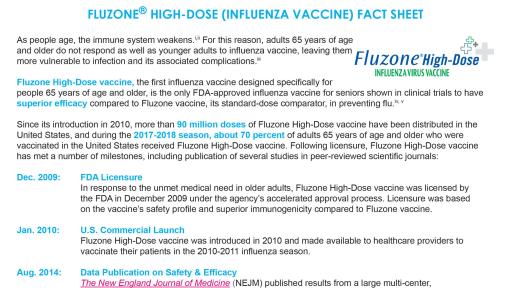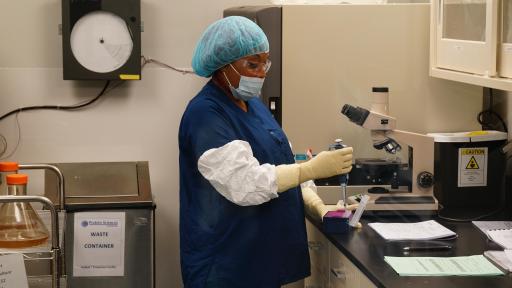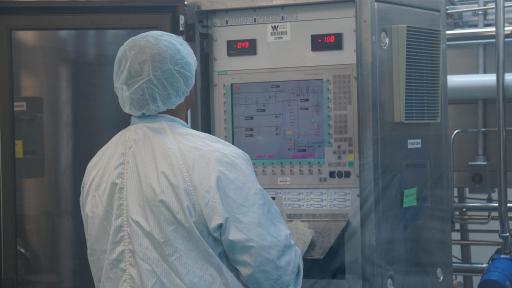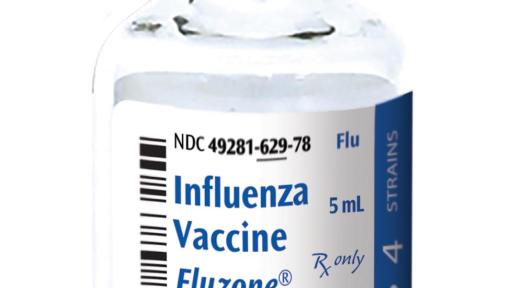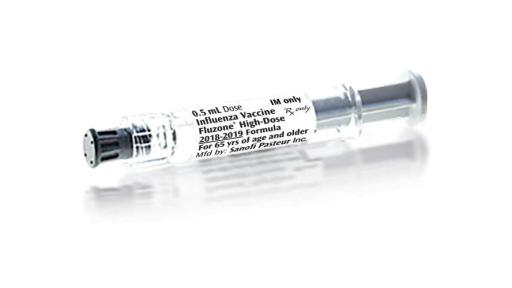Sanofi Ships First Flu Vaccines for 2018-2019 Season
- Nearly 70 million doses to be manufactured this season
- This includes 25 million doses of Flublok® Quadrivalent (Influenza Vaccine) and Fluzone® High-Dose (Influenza Vaccine), the only two flu vaccines proven to help prevent more cases of the flu in older adults, compared to their standard-dose flu vaccine comparators
- Initial shipments to be delivered to customers throughout August in time for the start of vaccination efforts
SWIFTWATER, Pa. – July 30, 2018 – Sanofi Pasteur, the vaccine division of Sanofi (EURONEXT: SAN) (NYSE: SNY), today shipped the first of its nearly 70 million flu vaccine doses to health care providers for the upcoming flu season. This year’s supply uses both egg-based and recombinant technologies, and includes increased production of Flublok Quadrivalent vaccine and Fluzone High-Dose vaccine, as well as continued supply of Fluzone® Quadrivalent (Influenza Vaccine).
The latest addition to Sanofi Pasteur’s flu vaccine offerings is Flublok Quadrivalent vaccine, which will be available to more providers across the country compared to previous seasons.
“This past flu season was a stark reminder of how unpredictable flu can be. It is important to get vaccinated even if vaccine effectiveness is lower than we would like. Vaccination saves many lives, helps prevent numerous hospitalizations, and helps protect individuals and the public at large from severe, life-threatening complications,” said David P. Greenberg, M.D., Associate Vice President and Regional Medical Head North America, Sanofi Pasteur. “We are proud that in recent years we have introduced two vaccines proven to help prevent more flu than their respective standard-dose flu vaccine comparators in older adults. We are dedicated to continuing to find new ways to improve flu vaccines, particularly for those most impacted every year.”
Improved Flu Vaccines to Help Protect Most Vulnerable Groups
Fluzone High-Dose vaccine: The first and only flu vaccine shown to have superior efficacy compared to Fluzone vaccine in helping to protect against the flu in adults 65 years of age and older (24.2 percent more effective).1 In additional studies, Fluzone High-Dose vaccine has also been shown to be more effective at preventing flu-like illness and flu-associated hospitalizations, pneumonia and cardiorespiratory events in older adults, compared to standard-dose flu vaccine.2 Sanofi Pasteur anticipates that two-thirds of all adults 65 years of age and older who will get a flu shot in the United States will receive Fluzone High-Dose vaccine.
Flublok Quadrivalent vaccine: Indicated for adults 18 years of age and older, and proven to help prevent more cases of flu in people 50 years of age and older compared to standard-dose quadrivalent inactivated flu vaccine (30 to 43 percent more protection).3 Flublok Quadrivalent vaccine is the only recombinant protein-based flu vaccine approved by the U.S. Food and Drug Administration (FDA), uniquely providing an exact genetic match of hemagglutinin (HA) from each recommended vaccine virus. HA is the protein identified as key to stimulating immunity to the flu.
Fluzone Quadrivalent vaccine: Helps protect against four flu strains (two A strains and two B strains) and was the first four-strain flu vaccine licensed for use in people 6 months of age and older.
Sanofi Pasteur is the nation’s largest supplier of flu vaccines for people 6 months of age and older, including the only two flu vaccines proven to help prevent more flu cases in older adults, compared to their standard-dose flu vaccine comparators.
Health care providers wishing to reserve vaccines can visit www.vaccineshoppe.com or call 1-800-VACCINE (1-800-822-2463). To search for a local flu shot provider, visit www.Fluzone.com or www.Flublok.com.
Important Safety Information for Flublok Quadrivalent, Fluzone Quadrivalent and Fluzone High-Dose Vaccines
Safety Information
Flublok Quadrivalent, Fluzone Quadrivalent and Fluzone High-Dose vaccines should not be administered to anyone who has had a severe allergic reaction (e.g., anaphylaxis) to any component (including egg protein for Fluzone Quadrivalent and Fluzone High-Dose vaccines) or previous dose of the corresponding vaccine. In addition, Fluzone Quadrivalent and Fluzone High-Dose vaccines should not be given to anyone who has had a severe allergic reaction to a previous dose of any influenza vaccine.
Tell your doctor if you have ever experienced Guillain-Barré syndrome (severe muscle weakness) after a previous dose of influenza vaccine. If you notice any other problems or symptoms following vaccination, please contact your health care professional immediately.
In adults, the most common side effects to Flublok Quadrivalent, Fluzone Quadrivalent, and Fluzone High-Dose vaccines include pain at the injection site, headache and muscle pains. In children, the most common reactions to Fluzone Quadrivalent vaccine include pain, redness and swelling at the injection site; muscle aches, fatigue and headache (irritability, abnormal crying, drowsiness, appetite loss, vomiting, and fever in young children). Other adverse reactions to these vaccines may occur. Vaccination with Flublok Quadrivalent, Fluzone Quadrivalent, or Fluzone High-Dose vaccine may not protect all individuals.
Indication
Flublok Quadrivalent, Fluzone Quadrivalent and Fluzone High-Dose vaccines are indicated for active immunization for the prevention of influenza disease caused by influenza A subtype viruses and type B virus(es) contained in each vaccine. Flublok Quadrivalent vaccine is approved for use in persons 18 years of age and older. Fluzone Quadrivalent vaccine is approved for use in persons 6 months of age and older. Fluzone High-Dose vaccine is approved for use in persons 65 years of age and older.
Before administration, please see the full Prescribing Information for Flublok Quadrivalent, Fluzone Quadrivalent or Fluzone High-Dose vaccine. Also, please see complete Patient Information for Fluzone Quadrivalent or Fluzone High-Dose vaccine.
About Influenza
Each year, about up to one out of every five Americans gets the flu and, on average, more than 200,000 people are hospitalized from flu-related complications.4 Flu seasons are unpredictable, with flu-related deaths ranging from 3,000 to as high as 49,000 people each year.5 Combined with pneumonia, the flu is one of the top 10 leading causes of death in the United States.6
Health officials recommend everyone 6 months of age and older, with rare exception, get a flu shot every year. Certain groups are at increased risk, including: children 5 years of age and younger, pregnant women, adults 50 years of age and older, and people with serious medical conditions like diabetes, cardiovascular disease, asthma and other chronic conditions.7
About Sanofi
Sanofi is dedicated to supporting people through their health challenges. We are a global biopharmaceutical company focused on human health. We help prevent illness with vaccines, provide innovative treatments to fight pain, and ease suffering. We stand by the few who suffer from rare diseases and the millions with long-term chronic conditions.
With more than 100,000 people in 100 countries, Sanofi is transforming scientific innovation into healthcare solutions around the globe.
Sanofi, Empowering Life
Media Relations Contact
Ashleigh Koss
Tel.: +1 908 981 8745
[email protected]
Investor Relations
George Grofik
Tel. +33 (0)1 53 77 45 45
[email protected]
Sanofi Forward-Looking Statements
This press release contains forward-looking statements as defined in the Private Securities Litigation Reform Act of 1995, as amended. Forward-looking statements are statements that are not historical facts. These statements include projections and estimates and their underlying assumptions, statements regarding plans, objectives, intentions and expectations with respect to future financial results, events, operations, services, product development and potential, and statements regarding future performance. Forward-looking statements are generally identified by the words “expects”, “anticipates”, “believes”, “intends”, “estimates”, “plans” and similar expressions. Although Sanofi’s management believes that the expectations reflected in such forward-looking statements are reasonable, investors are cautioned that forward-looking information and statements are subject to various risks and uncertainties, many of which are difficult to predict and generally beyond the control of Sanofi, that could cause actual results and developments to differ materially from those expressed in, or implied or projected by, the forward-looking information and statements. These risks and uncertainties include among other things, the uncertainties inherent in research and development, future clinical data and analysis, including post marketing, decisions by regulatory authorities, such as the FDA or the EMA, regarding whether and when to approve any drug, device or biological application that may be filed for any such product candidates as well as their decisions regarding labelling and other matters that could affect the availability or commercial potential of such product candidates, the absence of guarantee that the product candidates if approved will be commercially successful, the future approval and commercial success of therapeutic alternatives, Sanofi’s ability to benefit from external growth opportunities, to complete related transactions and/or obtain regulatory clearances, risks associated with intellectual property and any related pending or future litigation and the ultimate outcome of such litigation, trends in exchange rates and prevailing interest rates, volatile economic conditions, the impact of cost containment initiatives and subsequent changes thereto, the average number of shares outstanding as well as those discussed or identified in the public filings with the SEC and the AMF made by Sanofi, including those listed under “Risk Factors” and “Cautionary Statement Regarding Forward-Looking Statements” in Sanofi’s annual report on Form 20-F for the year ended December 31, 2017. Other than as required by applicable law, Sanofi does not undertake any obligation to update or revise any forward-looking information or statements.
1 Fluzone High-Dose vaccine [Prescribing Information]. Swiftwater, PA: Sanofi Pasteur Inc.
2 Lee J, Lam G, Shin T, et al. Efficacy and effectiveness of high-dose versus standard-dose influenza vaccination for older adults: a systematic review and meta-analysis. Expert Review in Vaccines. 2018; 17(5):435-443. https://www.ncbi.nlm.nih.gov/pubmed/29715054. Published online May 16, 2018. Accessed June 15, 2018.
3 Dunkle LM, Izikson R, Patriarca P, et al. Efficacy of recombinant influenza vaccine in adults 50 years of age or older. New England Journal of Medicine. 2017;376(25):2427-2436. https://www.nejm.org/doi/full/10.1056/NEJMoa1608862. Published online June 22, 2017. Accessed June 15, 2018.
4 Centers for Disease Control and Prevention (CDC). Seasonal Influenza-Associated Hospitalizations in the United States. http://www.cdc.gov/flu/about/qa/hospital.htm. Accessed April 27, 2018.
5 CDC. Key facts about influenza (Flu) & flu vaccine. http://www.cdc.gov/flu/keyfacts.htm. Accessed April 27, 2018.
6 Bastian AB, Kochanek DK, Murphy SL, et al. National vital statistics reports. Pg 1. http://www.cdc.gov/nchs/data/nvsr/nvsr64/nvsr64_02.pdf. Accessed April 27, 2018.
7 CDC. People at high risk of developing flu–related complications. https://www.cdc.gov/flu/about/disease/high_risk.htm. Accessed April 27,2018.



